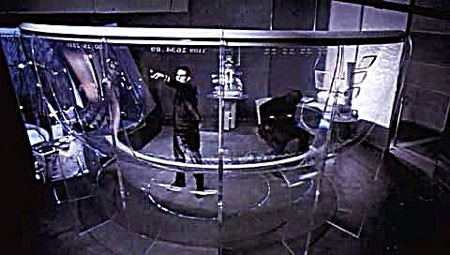You Can’t Have Too Many Screens
Adam Sender runs the Exis Capital Management Inc., a hedge fund in New York City. He also owns a $100 million modern art collection which he would like to house in an old church in the Hamptons. He has a lot of money and a need for a lot of information. This photo of him in his New York office in January 2007 was shot by Bloomberg News. As you can see, his desk is part performance art, part futuristic demo of what some believe work will be like in the future.

These flat screens were never meant to be piled up and around like this, but when these displays are free (as they essential are to this rich guy), they become a fantastic street use example of where display technology is headed. In this photo I counted 25 screens. Most of Sender’s screens don’t need to be interactive since they appear chiefly as displays of stock movements, which means they are good candidates for electronic wallpaper. If these screens were stitched together into a single desktop as many dual screen sets are (like my own desktop) it might be hard to keep track of where your control cursor was (at least until someone figured out a good way to highlight it across all that real estate).
These screens remind me of a project I once worked on. About 8 years ago, I was part of a small group invited by Steven Spielberg to brainstorm about a future film he was launching. There were some writer types (like myself), some technologists, a few futurists, and one or two science fiction authors, all members of the Global Business Network. Speilberg flew us to Venice Beach, California and holed us up in the Shutters on the Beach Hotel for a day and a half. I remember the spectacular beach was fogged in, so we spent the days in a dim conference room, as a constant stream of assistants whizzed in and out the whole time. We were working from a short story by Philip K. Dick, a sketch really (no script), which was set in the near future. Our assignment was to describe the details of what life would look like in Washington DC in the year 2050. Forecast the future of cars, bedrooms, office space in as realistic and accurate way possible. The movie, of course, was Minority Report.
At the time I had been trying to imagine the office of the future. I suggested to the film team that we would be surrounded by a single seamless screen in an arc, and that we would stand up and gesture into it. I had observed that when you think on your feet you have different thoughts. I like to think while I walk or pace because I feel my whole body is thinking then. It may turn out to be a short-term anomaly that today we think while we are sitting. Perhaps if the right technology were around we’d always think with our entire body in motion. I know I would rather move while mining for new ideas. With that in mind I offered the wall-sized screen arc that you stand before and act. You would interact with the information at a slight distance using your arms. Spielberg’s team found a great designer to make the idea real, and in a brilliant stroke of genius, they turned it into ballet by adding music.

I was simply describing the office I want. So far, Adam Sender is closest to this vision made real, although it is a long way from my ideal. I would be interested in hearing about other experiments in day-to-day surround-display. Can anyone point me to street-ready multiple displays hacked in home offices? How useful are they really? Can you keep track of what is happening behind you? Why not go up, rather than behind?


